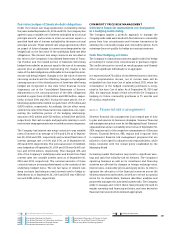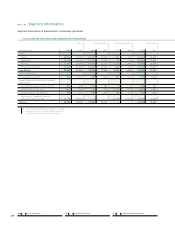Siemens 2014 Annual Report Download - page 303
Download and view the complete annual report
Please find page 303 of the 2014 Siemens annual report below. You can navigate through the pages in the report by either clicking on the pages listed below, or by using the keyword search tool below to find specific information within the annual report.
247 D. Consolidated Financial Statements 337 E. Additional Information
248 D. Consolidated Statements of Income
249 D. Consolidated Statements of Comprehensive Income
250 D. Consolidated Statements of Financial Position
251 D. Consolidated Statements of Cash Flows
252 D. Consolidated Statements of Changes in Equity
254 D. Notes to Consolidated Financial Statements
330 D. Supervisory Board and Managing Board
Siemens has a Company-wide portfolio approach which gener-
ates a benefit from any potential off-set of divergent cash flows
in the same currency, as well as optimized transaction costs.
The VaR relating to foreign currency exchange rates is calcu-
lated by aggregating the net foreign currency positions after
hedging by the operating units. As of September , the
foreign currency exchange rate risk based on historical volatili-
ties and correlations, a ten day holding period and a confidence
level of . % resulted in a VaR of € million compared to a
VaR of € million in the year before. The prior-year amount has
been adjusted in order to take into consideration modified
principles with regard to foreign currency exchange rate risk
management. Changes in euro values of future cash flows
denominated in foreign currency due to volatile foreign cur-
rency exchange rates might influence the unhedged portion of
revenues, but would also affect the unhedged portion of cost of
materials. Future changes in the foreign currency exchange
rates can impact sales prices and may lead to margin changes,
the extent of which is determined by the matching of foreign
currency revenues and expenses.
Siemens defines foreign currency exchange rate exposure
generally as items of the Consolidated Statement of Financial
Position in addition to firm commitments which are denomi-
nated in foreign currencies, as well as foreign currency denomi-
nated cash inflows and cash outflows from forecast trans-
actions for the following twelve months. This foreign currency
exchange rate exposure is determined based on the respective
functional currencies of the exposed Siemens’ entities.
Effects of foreign currency translation
Many Siemens units are located outside the euro zone. Since
the financial reporting currency of Siemens is the euro, the
finan cial statements of these subsidiaries are translated into
euro for the preparation of the Consolidated Financial State-
ments. To consider the effects of foreign currency translation in
the risk management, the general assumption is that invest-
ments in foreign-based operations are permanent and that re-
investment is continuous. Effects from foreign currency
exchange rate fluctuations on the translation of net asset
amounts into euro are reflected in the Company’s consolidated
equity position.
INTEREST RATE RISK
Interest rate risk is the risk that the fair value or future cash
flows of a financial instrument will fluctuate because of
changes in market interest rates. This risk arises whenever
interest terms of financial assets and liabilities are different. In
order to optimize the Company’s position with regard to inter-
est income and interest expenses and to manage the interest
rate risk, Corporate Treasury performs a comprehensive corpo-
rate interest rate risk management by using derivative financial
instruments. The interest rate risk relating to the Group, ex-
cluding SFS’ business, is mitigated by managing interest rate
risk actively relatively to a benchmark. The interest rate risk
relating to the SFS’ business is managed separately, consider-
ing the term structure of SFS’s financial assets and liabilities.
The Company’s interest rate risk results primarily from the
funding in U.S. dollar, GBP and euro.
If there are no conflicting country-specific regulations, all
Siemens operating units generally obtain any required financ-
ing through Corporate Treasury in the form of loans or inter-
company clearing accounts. The same concept is adopted for
deposits of cash generated by the units.
Assuming historical volatilities and correlations, a ten day
holding period and a confidence level of . % the interest rate
VaR was € million as of September , , compared to
a VaR of € million in the year before.
COMMODITY PRICE RISK
Siemens’ production operations expose the Company to vari-
ous commodity price risks in the ordinary course of business.
Especially in the Sectors Industry and Energy a continuous
supply of copper was necessary for the operating activities.
Commodity price risk fluctuations may create unwanted and
unpredictable earnings and cash flow volatility. The Company
employs various strategies discussed below involving the use
of derivative financial instruments to mitigate or eliminate
certain of those exposures.
Siemens has established a commodity price risk management
system to reduce earnings and cash flow volatility. Each
Siemens unit is responsible for recording, assessing, monitor-
ing, reporting and hedging its risks from forecast and pending
commodity purchase transactions (commodity price risk expo-
sure). The binding guideline for Siemens operating units pro-
vides the concept for the identification and determination of
the commodity price risk exposure and commits the units to
hedge it within a narrow band of % to % of the commod-
ity price risk exposure in the product business for the next three
months and % to % of the commodity price risk exposure
in the project business after receipt of order. Siemens operating
units are prohibited from speculative transactions.
























